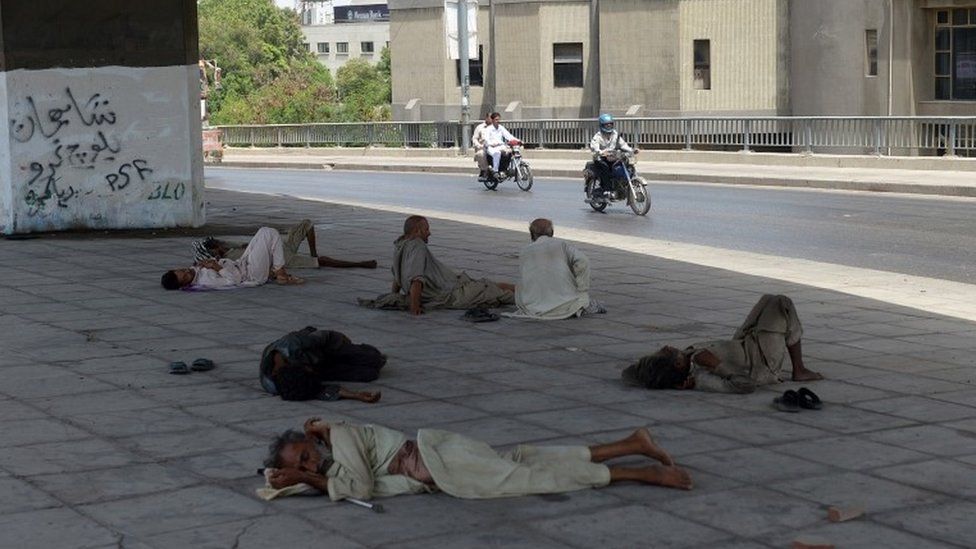Why did so many die in Karachi's heatwave?
- Published

Days after a heatwave in Pakistan killed about 1,300 people, many are still puzzled by the unusually high number of deaths in the port city of Karachi, reports Shahzeb Jillani.
In his 25 years working as a charity worker transporting casualties, Mohammed Bilal has never seen so many people die of heat.
"The bodies just kept coming from all over the city," he says.
Mr Bilal is in charge of the Edhi Foundation's main office in Karachi's congested commercial district near the country's main seaport.
Founded by Abdul Sattar Edhi, for decades the international charity has provided essential social welfare services in Pakistan and beyond.
In a city of 20 million people, Edhi's ambulance service usually transports 40 to 50 bodies a day. There have been times during the city's violent past when that number has gone up with a rise in shootings and killings.
But Mr Bilal can't remember having to deal with so many heat-related deaths.
"On Sunday, 21 June, we were the first ones to ring alarm bells when an unusually high number of dead bodies started arriving at our morgue," he recalls.
The Edhi morgue in Karachi is considered the biggest in the city, with capacity for 100 to 150 bodies. But even they couldn't cope.
"Over the next eight days, we received 900 bodies," says Mr Bilal. "We had to turn away so many families. Cemeteries ran out of spaces to bury the dead."
Up to 260 bodies were never identified. Officials believe many of them were either homeless people sleeping rough on the streets or drug addicts. Unclaimed and often nameless, they were later buried by the charity at the Edhi graveyard.
Temperatures above 40C (104F) affected large parts of Sindh and Balochistan province, so why was it Karachi, which bore the brunt of most deaths?
Was it because it happened in the month of Ramadan when many people fast from dawn to dusk? Or did prolonged electricity shortages and chronic water shortages exacerbate the problem? Still others wonder if pollution and climate change are to blame for the extreme weather.
One labourer told the BBC: ''It's so hot that I can barely speak''
The answer isn't entirely clear; though officials insist that it was perhaps the cumulative effect of all these factors, which led to hundreds of deaths.
The weakest and the most vulnerable were the worst hit, among them a large number of elderly people, many of who were already unwell.
"I have seen many hot summers in Karachi, but this was a suffocating heat I have never experienced before," says Shareef Ali, a 65-year-old resident of a low-income neighbourhood in Baldia Town who lost his ailing wife to heatstroke.
"It was difficult to breathe, as if the air had no oxygen."
'Angry and distraught'
What is clear is that most people, including the authorities, were caught unaware by the deadly impact of the heatwave. Pakistan's meteorological department was criticised for failing to forecast the calamity or issue any warnings.
Medics in government-run hospitals were overwhelmed and struggled to cope.
"We are used to a bit of chaos, but the scale of this calamity was too big," says Dr Seemi Jamali, who was on the frontline battling the crisis at Karachi's Jinnah Hospital.
With thousands of angry and distraught people outside the hospital, the situation could have turned violent, she says.
"If the army hadn't showed up in time to restore order, we wouldn't have been able to help thousands of heatstroke patients."
'Callous attitude'
Critics blame the provincial government in Sindh, run by former President Asif Ali Zardari's PPP party, for moving too slowly to address public misery.
While hundreds were dying in Karachi, Mr Zardari and other powerful members of his family chose to fly out of the country. The government was seen as unresponsive to the unfolding tragedy.
It was only a full week later that Mr Zardari's son and chairman of the PPP, Bilawal Bhutto-Zardari, flew back to Karachi and visited heat stroke patients at a government-run hospital.
By then, at least 1,200 people were dead in Pakistan's biggest city.
Mr Bhutto-Zardari and his ministers gave no explanation for their painfully slow response to the crisis. Instead, they blamed the deaths on the federal government and on power cuts they accused Karachi's privately run electricity company, K-Electric, of being responsible for.
Attempts by Pakistani politicians to deflect criticism and indulge in a mutual blame game appeared in bad taste.
As a senior Pakistani commentator, Zahid Hussain, put it: "More than the tyranny of the weather, it was the callous attitude of an inept provincial administration that was responsible for the death and suffering in Karachi."
How the body copes with extreme heat
The body's normal core temperature is 37-38C.
If it heats up to 39-40C, the brain tells the muscles to slow down and fatigue sets in. At 40-41C heat exhaustion is likely - and above 41C the body starts to shut down.
Chemical processes start to be affected; the cells inside the body deteriorate and there is a risk of multiple organ failure.
The body cannot even sweat at this point because blood flow to the skin stops, making it feel cold and clammy.
Heatstroke - which can occur at any temperature over 40C - requires professional medical help. If not treated immediately, the chances of survival can be slim.
There are a number of things people can do to help themselves. These include:
- wearing damp clothes which will help lower the body's temperature
- sticking one's hands in cold water
- placing fans next to windows as this will draw air from outside, which should be cooler
- wearing looser clothes
- having a lukewarm shower rather than a cold one
- fanning the face rather than other parts of the body
- Published25 June 2015
- Published26 June 2015
- Published22 June 2015